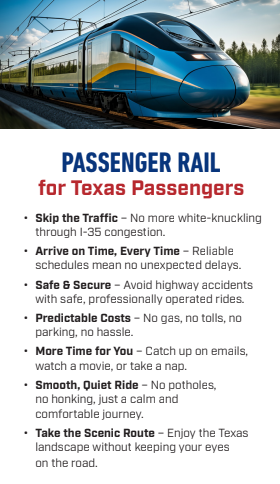Yogi Berra once said, “When you come to a fork in the road, take it."
While neither a Texan nor a transportation expert, he could have been describing the decision facing our state’s transportation funding right now.
Texas spends more money on roads than any other state. Of the $140 billion we will spend on roads in the next decade, $11 billion will go to build more lanes on Interstate 35 between Austin and San Antonio. Yet every credible study shows that even after that extraordinary expenditure, traffic congestion on IH-35 will only get worse.
We just can’t pour enough concrete to keep pace with population and trade growth.
For years, we built highways to connect rural farming communities to our urban centers. But today, 85% of Texans live in cities, primarily the Texas Triangle of Dallas-Ft Worth, Houston, and Austin-San Antonio. Our transportation needs have changed but our transportation spending has not. We continue to put hard-earned tax dollars into new highway lanes only to arrive back where we started: more congestion.
Other states – our economic competitors – have had enough of this doom cycle. Florida, Oklahoma, California, Georgia, and Nevada have recognized that building more roads does not solve congestion problems. Those states are tilting their transportation spending away from highways toward passenger rail because it is ultimately cheaper, faster, safer, more reliable, more energy-efficient, and congestion-proof.
Cheaper because adding capacity to a rail line merely requires adding rail cars, not expensive elevated lanes; faster because rail passengers whip past cars stalled in traffic; safer because a fatal accident by car trip is 17 times more likely than on rail; more reliable because trains avoid congestion; and more efficient because train travel requires half the energy of cars over the average trip. Hands-free train travel providing time for working or studying while in transit is also less stressful and more productive than white-knuckling up or down IH-35, IH-10, IH-45 or any other dangerous and congested highway in the state.
It’s time for Texas to take that fork in the road by beginning to incrementally supplement highways with congestion-proof passenger rail connecting the Texas Triangle cities. The State Legislature – meeting now – has the opportunity to put our state onto a smarter trajectory toward fiscal sanity, freedom of choice, and guaranteed future mobility.
A group of local elected officials from across the state have requested that the Legislature set aside $300 million this biennium to begin the transition to passenger rail. The money would be used as a 20% match for an 80% share of available federal funding to create an initial passenger rail fund of $1.5 billion – a good start for a gradual, generational transformation in Texas transportation funding.
Existing rail lines where possible and some existing highway corridors where necessary could be upgraded to provide ‘higher-speed’ services operating at 110-150-mph – plenty fast enough for the short distances involved and at less than a third of the cost of true ‘high-speed’ rail (220-mph). With just the initial funding, existing rail lines can be upgraded to safely move more freight (getting trucks off highways) and develop conventional passenger services, increasing current speeds and frequencies gradually to achieve trip times equal to or faster than car trips.
The true professionals within the Texas Department of Transportation know this transition is inevitable, given our projected population growth, but require legislative direction and funding to act upon that knowledge.
For perspective, the $300 million being sought by local leaders represents a fraction of the state’s $300-plus billion budget this session and less than 1.26 % of the projected $23.8 billion surplus.
Texans are tough but we’re also tired. We’re tired of outdated transportation planning, tired of being stuck in traffic, and tired of an endless succession of spaghetti-bowl interchanges that grow more complicated and more expensive with every new highway expansion.
We’ve come to that fork in the road. Now let’s take it.
John Thomaides, former mayor of San Marcos and Chairman, Austin-San Antonio Corridor Council
Ross Milloy, President, Austin-San Antonio Corridor Council

